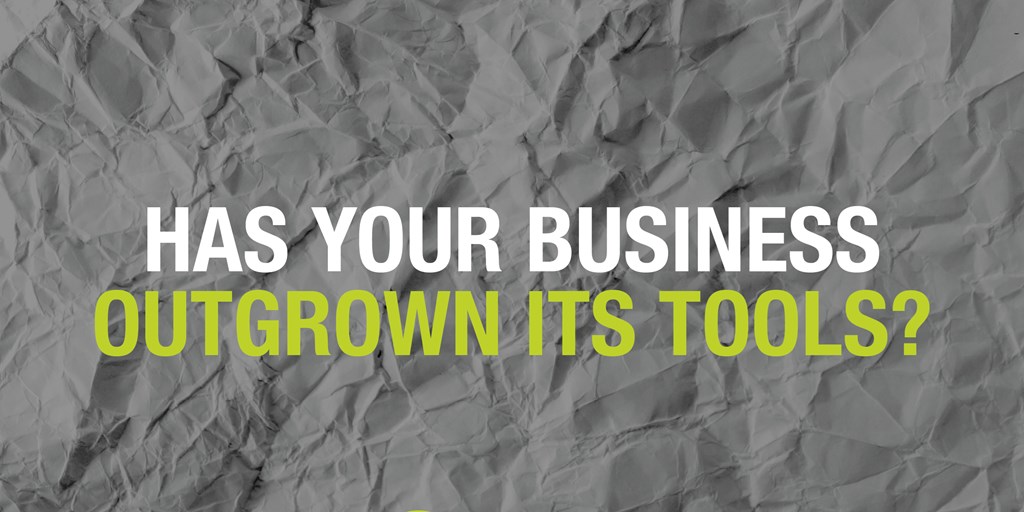Do you feel you’ve outgrown the tools you’re using to run your business? Do you think you could be working more efficiently if only you had a better way to get the job done? If so, read on. Following on from our previous blog post on the use (or overuse) of spreadsheets within organisations, we thought about other common scenarios we encounter when completing a task analysis. A common issue is that efficiency can be compromised when tools don’t evolve at the same pace as tasks. Your organisation and the market you operate in might be changing at a quick pace, but to keep up, are your people using work-arounds in their existing tools, rather than thinking about which tool could do the job better?
Do you feel you’ve outgrown the tools you’re using to run your business? Do you think you could be working more efficiently if only you had a better way to get the job done? If so, read on.
Following on from our previous blog post on the use (or overuse) of spreadsheets within organisations, we thought about other common scenarios we encounter when completing a task analysis. A common issue is that efficiency can be compromised when tools don’t evolve at the same pace as tasks. Your organisation and the market you operate in might be changing at a quick pace, but to keep up, are your people using work-arounds in their existing tools, rather than thinking about which tool could do the job better?
The Task-Tool Lag
When we consider what can be done to simplify and improve your workflow, the first thing we do is discover the practices of your business and the tools you use (e.g. paper, telephones, email, software, spreadsheets or apps). In many cases the tasks described can be boiled down to a combination of:
• Collecting and storing data
• Processing or transforming that data from one form to another
• Moving it around or communicating it
• Analysing and reporting on it
Various tools can be used to achieve each of these tasks, but differ greatly when it comes to effectiveness and efficiency. For example, for collecting and storing data, an Excel spreadsheet might do the job for one task, but for another a database will work much better.
What we often find is that the effectiveness of each chosen tool varies as the task changes over time, which it inevitably does as the business or the processes evolve. To adapt, people will often progress through a series of tools, but invariably there’s a lag, and they’ll be one step behind the most suitable tool to get the job done simply and effectively. This is often referred to as system maturity – how well your system matches your business requirements.
To help you assess whether you have a task-tool lag and could do with developing new tools, let’s take a quick look at the most common business tools and how organisations usually evolve from one to the other. We’ll start with the most ancient – paper.
Paper
Yes, this is the good old-fashioned way of doing something, and we come across paper-based systems all the time. Storing paper documents may still be appropriate in some cases, for example if you work in a sector that has the preservation of paper files as part of its regulatory requirements, or simply because the data is captured on paper in the first place.
However, as the volumes increase so does the cost of storage and the difficulty of finding things. To solve this, organisations often move on to scanning and storing documents electronically, cutting storage costs and making rapid retrieval possible.
When you need to process the information that’s being collected on paper, you may already have moved on to cutting manual data entry by encouraging the use of web-based forms that feed directly into your database, or in some cases you may even have chosen to use machine reading.
We’ve seen examples in which all documents related to a “case” were printed and stored in a paper filing system that took up considerable office space. The location of the physical files was then recorded in a database for operational and/or statistical purposes. The administrative workflow involved physically moving paper documents between shelves as the case progressed, with the additional task of cataloging some of that information in a computer. The database offered little value to the process at all.
Email is great for ad-hoc communication, and it may well be a good way to distribute documents and receive documents and other electronic files. An example would be a company that runs monthly statistics reports for one of their customers. Because they do it for a single customer, the most appropriate and cost-effective method is to run the reports manually and then email the files to the people that need them. No more automation is required. However, should the company request daily reports, or more companies require them, the process and tools may need a re-think.
As time passes there are often problems with managing the sent and received files, for example, referring to different versions of the same file.
There are potential security and reliability issues here too. If the data is sensitive, the risk of that inadvertently ending up in the wrong hands is relatively high. I’m sure we’ve all sent an email to the wrong contact in our address book at one time or another. Also, with email it’s harder to be sure that your message actually gets to its destination, and it requires more effort to troubleshoot if things go wrong.
Despite these issues, using email tends to become ingrained in the distribution of information, possibly because it’s flexible and universal, and its use is remarkably resistant to change. However, to improve efficiency, messaging systems can be integrated with custom-built databases or applications, making it far easier to distribute large volumes of information automatically or with just a few clicks.
Off-the-Shelf Software, Spreadsheets & Other Desktop Software
For many tasks, spreadsheets, common desktop software or off-the-shelf software may be perfect for the job. For common processes such as business accounting or basic order management, there are a plethora of downloadable or off-the-shelf on-line systems that are reasonably flexible and good value. However, sometimes they can be too generic and don’t exactly match your business needs, especially as these needs start to change.
In other cases, they may provide you with the perfect solution for at least some of your tasks, but only a small subset. Then you have three options: you can struggle on using complicated workarounds to achieve your specific needs; you can wait (and hope) that the required features to be added; or you can ask the provider to add them, which can be very costly.
What we often see is people “filling the gaps” in their off-the-shelf products by using spreadsheets, word processing tools or the likes of PowerPoint, Visio or Exchange. (We said quite a lot about the potential pitfalls of spreadsheets in our last blog post.)
In many cases these applications and/or off-the-shelf software are used successfully in the early stages of a business, but as volumes and complexity increase we see a trend towards custom-built “first generation” software otherwise known as “The Company Database”.
First-Generation Custom-Built
Often written by an employee, friend or contact who “knows IT”, and using a database management tool such as Access or Filemaker Pro, “The Company Database” is a common next step for many organisations. This first-generation software provides the highly specialised features required for the business. It works well, possibly for a long period, but ultimately we see a common set of problems as the organisation grows and the requirements change. These problems include:
• Constant maintenance and changes taking up a costly amount of time to implement
• Increasing numbers of concurrent users and data make the system unwieldy or unmaintainable
• Staff having to do extra tasks to work around the limitations of the system
• Knowledge of the system lies with a single person who at some point becomes unavailable. (We have encountered businesses where the in-house developer has left the company to set up new business selling the same software and services back to the company that paid for it to be developed.)
This is all too often when people come to us, looking for a next generation custom-built system.
Are You Ready For The Next Step?
If the challenges described above fit your organisation, then it’s likely you’ve outgrown the tools you’re using to run your business. As your processes have changed over time, the systems you’re using could be getting to the end of their useful life or just need updating.
A professionally developed, bespoke system could be the answer. It can be built to meet your unique business requirements with a user interface designed around your staff’s tasks and needs. It should make your life easier, simplify management, and improve the way you work. But what would be the best way to do it? You could hire an in-house development team if your business is big and robust enough, or you could outsource development. Both have pros and cons, depending on your requirements and your resources.
If you think your organisation may be ready to look at developing your own software, though please get in touch. We’re happy to do a free initial consultancy and short follow-up report on what you next generation business system could look like and the most cost-effective way of developing it.


